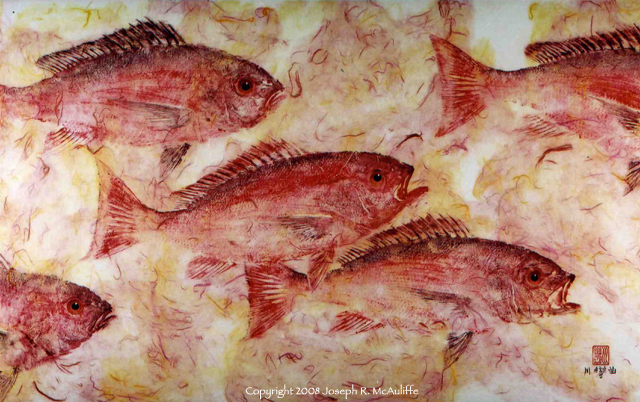
The Pacific red snapper (Lutjanus peru) is found along the Pacific coast of the southern part of Baja California, within the Gulf of California, along the west coast of mainland Mexico and Central America, and possibly south to Peru.
This species and other many other members of the snapper family (Lutjanidae) are highly prized because they make excellent table fare and as a consequence, many populations face heavy fishing pressure. Since most species of snappers generally grow slowly and have moderately long lifespans, they are vulnerable to overfishing. Consequently, populations of some species have clearly declined over the last several decades. For example, the annual commercial catch of the northern red snapper (Lutjanes campechanus) in the northern Gulf of Mexico declined steadily from about 10 million pounds in the 1960s to less than 6 million pounds during the 1980s, despite increased fishing effort. The U.S. government has imposed a cap on the total annual harvest in U.S. coastal waters of the Gulf of Mexico as one measure to help rebuild the stocks of this valuable resource. Excessive fishing pressure not only causes population reductions, it also reduces the average size of fish in the population. This reduction in average size can have a significant, negative influence on population recovery since small fish contribute less to population recovery than do larger fish (small females produce far fewer eggs than do larger females). Overharvest in the Gulf of Mexico is not due only to commercial fishing. In the 1990s the total harvest of northern red snappers by recreational fishers was approximately the same as that harvest by commercial fishers. Another heavy impact on the northern red snapper in the Gulf of Mexico is shrimp trawling. Many small, juvenile red snappers are inadvertently caught by shrimp trawls and are discarded overboard as “by-catch.” Scientists have estimated that the mortality of northern red snapper in the Gulf of Mexico due to shrimp trawler by-catch may exceed the mortality due to the combined effects of both commercial and recreational fishing.
There is relatively little information about the population status of the Pacific red snapper. However, the by-catch of juvenile fish by shrimp trawlers in the southwestern Gulf of California also is a significant source of mortality. Although the population might be able to sustain present rates of direct harvest by fishers, the added mortality due to shrimp trawling along the coast of Mexico has been suggested to be unsustainable and may inevitably contribute to a significant population decline.
In this piece, multiple impressions of a single fish were made with red and black inks on a colorful sheet of hand-made Japanese akebono paper.
Size: 36 x 22 inches (2003; on display and for sale at Ebisu Sushi & Grill Restaurant, Anthem, Arizona)
Return to Gallery 2.